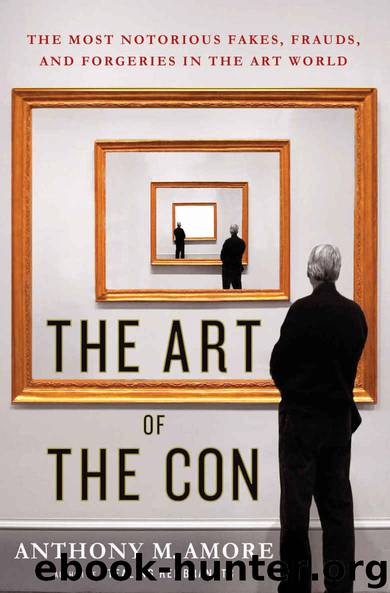The Art of the Con: The Most Notorious Fakes, Frauds, and Forgeries in the Art World by Anthony M. Amore

Author:Anthony M. Amore [Amore, Anthony M.]
Language: eng
Format: epub, azw
Tags: Non-Fiction, Art, True Crime
ISBN: 9781137279873
Amazon: 1137279877
Goodreads: 23014716
Publisher: St. Martin's Press
Published: 2015-07-13T23:00:00+00:00
Seven
The Double Dealer
In the heart of Roslyn Heights, New York, between a psychic reading center and a sports rehabilitation complex sits a newly constructed pale-brick building belonging to the Chabad of Roslyn. The cube-like structure features a prominent Modernist rendering of a menorah extending above the building’s roofline. The impressive menorah is functional, lit each year to celebrate Chanukah. It’s also billed by the Chabad of Roslyn to be one of the tallest menorahs in the world (without exceeding the 30-foot height limit set forth by Jewish law). The Roslyn Chabad movement is the beneficiary of the Ely Sakhai Torah Center at that location, where the faithful may visit for a variety of services, ranging from lectures to Jewish services to adult education. The Torah Center is named for its benefactor, a Jewish émigré from Iran committed to his faith and heritage who was eager to make a mark among his people in his adopted homeland.
Ely Sakhai1 moved to the United States in 1962 at the age of ten and would go on to donate millions of dollars to Jewish charities. Prone to loud attire and flashy jewelry, the pot-bellied antiques dealer with a thin mustache and dark, receding hair became well known for his philanthropy in Long Island, where he made his home.2 And in addition to his generosity in providing money to support his fellow Jews, in 2009 Sakhai helped to right a wrong committed by the Nazis during World War II.
In 1940, Adolf Hitler’s forces invaded the previously neutral nation of Belgium. It took the Germans less than three weeks to force the Belgians to surrender, leading to more than four years of Nazi occupation. Finally, in 1944, Canadian and Allied forces liberated Belgium, but not before Nazis had looted art from many families, including one Belgian family that was forced to flee its Ohain apartment in order to seek refuge in the countryside. After the liberation they returned home to find that five oil paintings had been taken by the Nazis, the same fate as so much art throughout Europe. They were left with no other recourse but to file a claim for their missing paintings with the Belgian office for looted art, and the works were listed in the Répertoire d’oeuvres d’art dont la Belgique a été spoliée durant la guerre 1939–1945, a listing of Belgian war losses.3 Among the paintings that were taken was a portrait of their young daughter with her pet rabbit, which they had commissioned to be painted by the famed Belgian artist Anto Carte.
Carte was a leading Belgian artist who rose to prominence after the First World War. The son of a carpenter, Carte was drawn to decorating at a young age and started evening painting classes before he even reached his teenage years at the Academy of Bergen. He then attended the Royal Academy of Brussels after winning a scholarship and studied under Jean Delville and Constant Montald. While studying theater decoration in Paris, he encountered the
Download
The Art of the Con: The Most Notorious Fakes, Frauds, and Forgeries in the Art World by Anthony M. Amore.azw
This site does not store any files on its server. We only index and link to content provided by other sites. Please contact the content providers to delete copyright contents if any and email us, we'll remove relevant links or contents immediately.
Mindhunter: Inside the FBI's Elite Serial Crime Unit by John E. Douglas & Mark Olshaker(9206)
Wiseguy by Nicholas Pileggi(5674)
Room 212 by Kate Stewart(5040)
Hitman by Howie Carr(5022)
Secrecy World by Jake Bernstein(4651)
Killers of the Flower Moon: The Osage Murders and the Birth of the FBI by David Grann(4387)
Papillon (English) by Henri Charrière(4199)
Breaking Free by Rachel Jeffs(4175)
Killers of the Flower Moon by David Grann(3971)
Say Nothing by Patrick Radden Keefe(3903)
American Kingpin by Nick Bilton(3759)
The Secret Barrister by The Secret Barrister(3615)
Molly's Game: From Hollywood's Elite to Wall Street's Billionaire Boys Club, My High-Stakes Adventure in the World of Underground Poker by Molly Bloom(3486)
Mysteries by Colin Wilson(3397)
In Cold Blood by Truman Capote(3311)
Signature in the Cell: DNA and the Evidence for Intelligent Design by Stephen C. Meyer(3075)
I'll Be Gone in the Dark by Michelle McNamara(3024)
Rogue Trader by Leeson Nick(2977)
Bunk by Kevin Young(2950)
